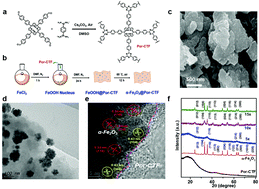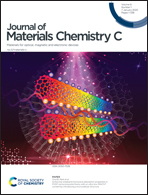An artificial photosynthesis system comprising a covalent triazine framework as an electron relay facilitator for photochemical carbon dioxide reduction†
Abstract
Natural photosystem II, which utilizes multiple photosensitizers, is essentially an organic–inorganic hybrid system, and comprises electron transfer relay processes. The relay processes can facilitate charge transfer and reduce charge recombination. Thus it can significantly improve photocatalytic performance. Such a strategy has rarely been studied for CO2 reduction in conjugated porous polymers. Here we report a new organic–inorganic hybrid material, which constitutes an electron transfer relay photocatalytic system for CO2 reduction using a porous framework as a relay facilitator. The system was fabricated by decorating a new porphyrin-based covalent triazine framework (Por-CTF) with α-Fe2O3 nanoparticles using an in situ strategy, which was then coupled with a Ru complex photosensitizer. Owing to the formation of an electron transfer relay system, the ternary system exhibits a sharp enhancement in photocatalytic activity towards CO2 reduction to CO as compared with the binary system. The best performance given by the electron transfer relay system (α-Fe2O3@Por-CTF-10×/Ru(bpy)3Cl2) produces a catalytic CO evolution rate of 8.0 μmol h−1 with 93% CO selectivity, which is obviously superior to that of the binary system. The highest apparent quantum efficiency was also evaluated as 1.43% at 450 nm. This work provides a prototype model system for the design of an artificial photocatalytic system for photochemical CO2 reduction.



 Please wait while we load your content...
Please wait while we load your content...